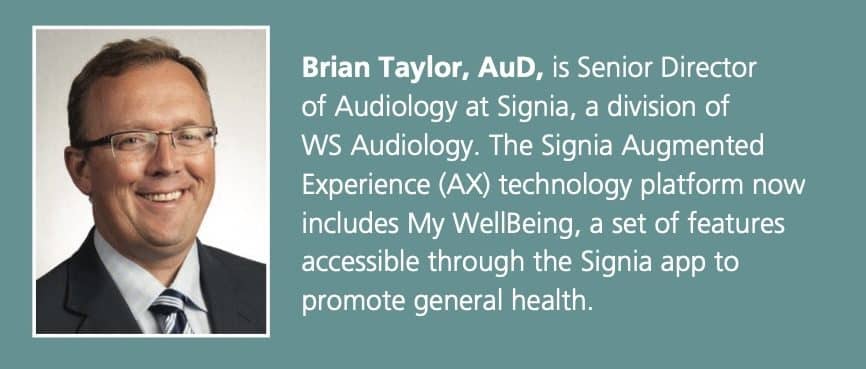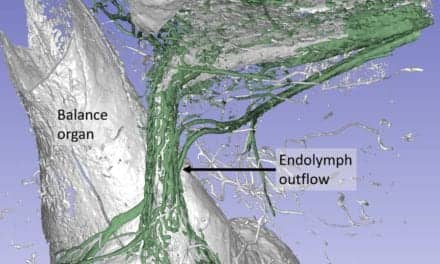New technology could appeal to younger users, encourage greater adoption, and promote better well-being.
Tech Topic | March 2023 Hearing Review
By Brian Taylor, AuD
As hearing care professionals, we face a couple of challenges when working with patients: getting them to embrace hearing care earlier in life, and if that care includes hearing aids, getting them to wear those hearing aids longer, so they can do the most good. And not just by amplifying sound.
After all, we know hearing loss affects health and well-being.1 Still, people with hearing loss are often reluctant to wear hearing aids. When they do seek help (on average, about seven years after they learn they need it), we know that the more patients wear their hearing aids throughout the day, for instance the healthier they tend to be. Better hearing leads to greater well-being. HCPs can’t emphasize that enough.
Recently, the World Health Organization estimated more than 1.5 billion people worldwide live with hearing loss, a number that could grow by another billion.2 The health ramifications are, therefore, significant. Hearing loss has been linked to an increased risk of cardiovascular disease, diabetes, and other conditions. And social isolation caused by hearing loss leads to a greater risk of depression, cognitive decline, and dementia.3
Therefore, HCPs are on the frontline of general health and well-being. Making the connection between hearing health and overall health is critical. But so is presenting patients, especially younger patients, with lifestyle solutions that strengthen that connection and inspire them to improve their lives.
Traditional hearing aids are obviously a solution. But a new class of wellness aids is another, promoting better well-being through amplification, advanced processing, sensor technology, and real-time health tracking. A Fitbit for the ears, but better.
Better Hearing, Wellness, and Patient Engagement
Several years ago, the first hearing aids with built-in fitness trackers came to market. In addition to amplifying sound, they could track steps, like a Fitbit or Apple Watch.
In the years since, technology has advanced to the point where hearing aids can serve as universal wellness devices, not only tracking steps but also monitoring social engagement, overall activity, and actual wear time. When hearing aids are a lifestyle choice and not just a healthcare solution, they can have a more profound effect on well-being.
To many, including younger groups, wearables are lifestyle devices一things they use throughout the day. For those who also require hearing assistance, wearables that combine lifestyle functions with amplification, natural sound processing, and clarity offer a holistic approach to well-being. Plus, they give HCPs an opportunity to intervene when patients are younger, make the case that they should wear their hearing aids longer, and provide ongoing engagement through discussions of wellness features, settings, and outcomes.
Technology Advances in Wellness Hearing Aids
There are two main ways that select modern wellness hearing aids are more advanced than previous versions. First is their integration of greater sensor technology for detecting the world around the wearer. Second is innovative processing for distinguishing and enhancing the wearer’s own voice.
Each contributes to better hearing health, regardless of fitness tracking. Sensors help the hearing aids adjust sound, for instance, when the wearer is in motion. Unique digital processing isolates the wearer’s voice and improves its sound to overcome a common communication challenge of hearing aid users; they hate the way hearing aids make them sound to themselves.
But these two technology advances, combined with accelerometer technology inside the hearing aid (which frankly does a better job tracking steps than accelerometers on the wrist), also form the foundation of this new generation of wellness aids. At Signia, we call it My WellBeing, and it capitalizes on the innovations we’ve made in hearing health to address general health and encourage patients to take ownership of their wellness.
Encouraging Longer Wear Times, Physical Activity
The ultimate goal is to encourage patients to wear hearing aids and wear them longer. Studies show that usage time can help determine perceived benefit,4 with six or more hours of wear time per day seen as a threshold.5 People tend to be more active when they can better hear environmental cues during their workouts. They engage more with others when they’re confident in their ability to hear and communicate.
Certainly, advances in hearing aid design encourage longer wear times. Electronic miniaturization and leaps in software processing have enabled form factors that are more discrete, even fashionable. And the introduction of rechargeable hearing aids has been a big step in wider adoption.
But incorporating wellness features will spur longer, healthier usage. Our data has shown a positive correlation between hearing aid wear time and physical activity, as detected by the sensor technology in our hearing aids. And in terms of wellness aids specifically, early research into Signia hearing aids with My WellBeing indicate even moderately active people (those reporting detected physical activity roughly one-third of the day) tend to wear their hearing aids one to one-and-a-half hours longer than less active wearers.
How Hearing Aids Can Get Wearers Moving
The wellness features of these Signia hearing aids fall into four areas: wear time, step tracking, activity tracking, and social engagement. The first two are straightforward: encouraging people to wear their hearing aids longer remains the core goal and delivering more accurate step counts without a separate tracker is table stakes for such devices.
The second two represent the further evolution of hearing aids into holistic health platforms. Activity tracking is possible through the motion sensors used to aid sound processing. The sensors can track when a person is engaged in moderate activity (a brisk walk) or more intense activity (a run). Social engagement tracking relies on Signia’s exclusive Own Voice Processing (OVP) 2.0 technology to determine when the actual wearer and not the people around them are engaged in conversation. The more conversation, the healthier the engagement.
Motion sensors and OVP 2.0 can improve the hearing experience for wearers. But when they double as wellness trackers, they’re a game-changer. HCPs recognize that audiograms aren’t the only (or even best) way of assessing auditory wellness.6 Making the connection to general health is key. This new category of wearable wellness devices provides that connection and could help broaden adoption of hearing aids at a time when they’re needed most.

Citation for this article: Taylor B. Hearing Aids as Wellness Devices Mean Deeper Engagement with Patients. Hearing Review. 2023;30(3):22-23.
References
- Davis AC, Hoffman HJ. Hearing loss: rising prevalence and impact. Bulletin World Health Organization. 2019;97(10):646–46A.
- United Nations. Over one billion people at risk of hearing loss: WHO. UN News. 2022.
- Deal J, Reed N, Kravetz A, et al. Incident hearing loss and comorbidity a longitudinal administrative claims study. Otolaryngology-Head and Neck Surgery. 2018.
- Houmøller SS, Wolff A, Möller S, et al. Prediction of successful hearing aid treatment in first-time and experienced hearing aid users: using the international outcome inventory for hearing aids. International Journal of Audiology. 2022;61(2):119-129.
- Wong L, Hickson L, McPherson B. Hearing aid satisfaction: what does research from the past 20 years say? Trends in Amplification. 2003;7(4):117-161.
- Humes L. 20Q: assessing auditory wellness in older adults. Audiology Online. 2022;article 28087.





